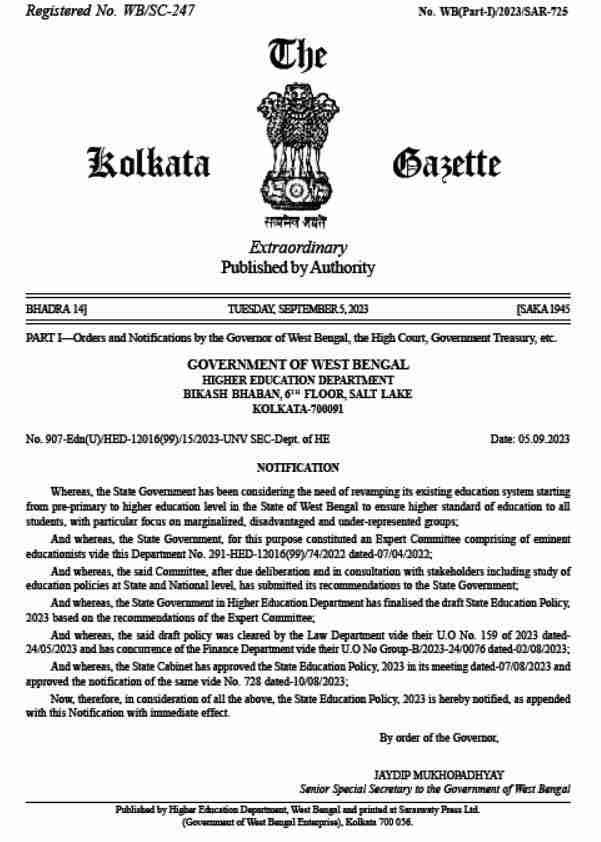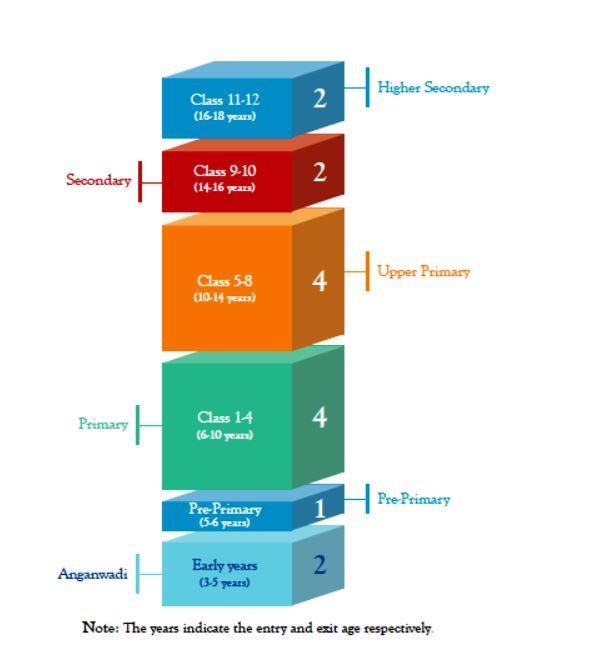This Post Contents
New Education Policy 2023 In West Bengal PDF– The state government has been considering the need of revamping its existing education system starting from Pre-Primary to higher education level in the state of West Bengal to ensure higher standard of education to all Students, with particular focus on marginalized, disadvantaged and under-represented groups.Yesterday govt of West Bengal published New Education Policy 2023 In West Bengal PDF. From Here you can download this “WB New Education Policy 2023”.
To read this “WB New Education Policy 2023” in Bengali – click here
Click Here To Download “New Education Policy 2023 In West Bengal PDF” in PDF format -from serial no 220
The State Government, for this purpose (New Education Policy 2023 In West Bengal PDF-WB New Education Policy 2023) constituted an Expert Committee comprising of eminent educationists vide this Department No. 291-HED-12016(99)/74/2022 dated-07/04/2022.The State Government in Higher Education Department has finalized the draft State Education Policy, 2023 based on the recommendations of the Expert Committee.

Accordingly, the present vision for education in West Bengal is being envisaged for the next 13 years, i.e. up to 2035 after which the Policy can be revisited. This will enable Bengal to have an Education Policy which will retain contemporary relevance, along with specific goals.
Structure of School Education
• The present structure of school education in West Bengal follows a 5+4+2+2 pattern. Beginning with one year of pre-primary and four years of primary till Class 4, the students move through four years of upper primary, to two years of secondary and two years of higher secondary.

• It is proposed that the same pattern should continue to be followed in the state. The only change suggested in the structure is the inclusion of the first two years of early years’ education at an Anganwadi centre. This would be followed by one year of pre-primary at a government or private pre-primary school. The existing structure of primary, upper primary, secondary and higher secondary would remain as it is.
Primary Education
• West Bengal ranks first in the category of large states in the ‘Foundational Literacy and Numeracy Index’ report. As per the Foundational Learning Study 2022 by NCERT, West Bengal has the highest proportion of children performing at or above the Global Minimum Proficiency level in foundational numeracy in India.
• The School Education Department has initiated the process for universalisation of foundational literacy and numeracy (FLN) by 2025. The FLN campaign may be launched under a name such as “Daksha Bangla”. The learning outcomes from pre-primary to Class 4 may be reviewed and updated to bring parity and uniformity.
Teacher Transfer Policy
• To maintain the suitable PTR in districts the Government may consider framing a policy for compulsory service of teachers in the rural areas of the State for 5 years / suitable period in line with compulsory services of medical doctors, as decided by the Government at the time of recruitment. Though the state shows a healthy trend of pupil teacher ratio (PTR) at a macro level, there are disparities at the district, block and school level. The School Education Department to develop a suitable general policy for transfer of teachers so that PTR in a particular school or region is maintained.
• Such a policy may be drafted after a suitable micro-level analysis of the situation.The number of sanctioned teaching posts in schools across the state should be reviewed and revised, keeping in line with the present trends of enrollment. Such a move would help normalize the PTR across all regions.

Performance linked Promotion Policy
• A promotion policy should be developed for school teachers at all levels. Academic Performance Indicators (APIs) scrutinized by a Review Committee with recommendations should be used for this purpose in order to develop a transparent and objective metric for promotion.
The School Education Department should be advised by the Boards of Primary, Secondary and Higher Secondary education on the same. Such a policy should motivate the teachers to be strongly committed to the cause of education.
• The Committee recommends that a survey be made on the number of Para Teachers engaged at present in schools under School Education Department and a suitable policy should be devised to ensure their future growth.
| Management 2020-21 | |||
| Number | Percentage | ||
| Schools | Government | 83484 | 87.6 |
| Aided 87 | 0.09 | ||
| Private | 11687 | 12.3 | |
| Total 95,258 | |||
| Enrollment | Government | 1,58,70,894 | 83.7 |
| Aided 46595 | 0.25 | ||
| Private | 30,56,276 | 16.1 | |
| Total 1,89,73,765 | |||
| Teachers | Government | 4,69,804 | 81.83 |
| Aided 1,003 | 0.17 | ||
| Private | 1,03,317 | 17.99 | |
| Total 5,74,124 | |||
FAQs
What are the new WB education policy 2023?
The West Bengal Govt has finally published its New State Education Policy 2023. Here they change to many thing. he New Education Policy in India aims to provide equitable and quality education for ages 3–18.
What is 5+4+2+2 format in WB New Education Policy 20230
The present structure of school education in West Bengal follows a 5+4+2+2 pattern. Beginning with one year of pre-primary and four years of primary till Class 4, the students move through four years of upper primary and finally two years each of secondary and higher secondary. The same pattern should continue to be followed in the state as the administrative structures are in place to meaningfully support the learners in this set-up. Any significant modification to this pattern will require a major shuffling of resource allocation and would thus be detrimental to the quality of education being delivered to the learners.


![[PDF]wb obc list before 2010,wb obc cancel list,west bengal obc list before 2010 pdf download west_bengal_obc_list_before_2010_pdf_download](https://www.wbedu.in/wp-content/uploads/2024/05/west_bengal_obc_list_before_2010_pdf_download-218x150.jpg)
![[PDF]253 bed college list in West Bengal PDF,253 bed college cancel list West Bengal,very big important news 253_bed_college_list_in_West_Bengal_PDF](https://www.wbedu.in/wp-content/uploads/2023/11/253_bed_college_list_in_West_Bengal_PDF-218x150.jpg)
![[calendar] West Bengal govt calendar 2024,West Bengal Government Holiday Calendar 2024,very big good news West_Bengal_govt_calendar_2024](https://www.wbedu.in/wp-content/uploads/2023/11/West_Bengal_govt_calendar_2024-100x70.jpg)
![[Calculator]WB Primary Teachers Recruitment Weightage Calculation,WB Primary TET Weighatge Calculator 2022,very big news WB_Primary_Teachers_Recruitment_Weightage_Calculation](https://www.wbedu.in/wp-content/uploads/2022/10/WB_Primary_Teachers_Recruitment_Weightage_Calculation-100x70.jpg)
![[Download-Print]wb primary tet admit card 2023 download,wb tet admit card 2023,wb tet admit card 2023 release date 2017_tet_exam_admit_card](https://www.wbedu.in/wp-content/uploads/2021/01/2017_tet_exam_admit_card-100x70.jpg)